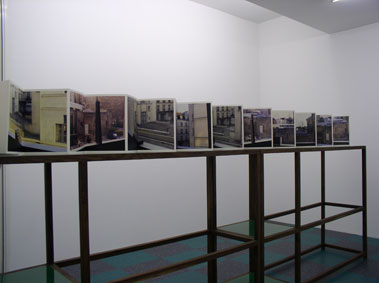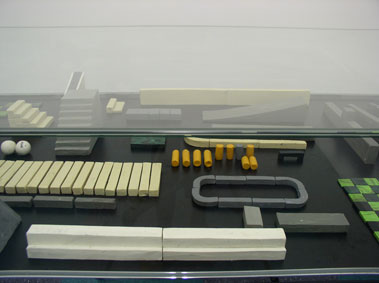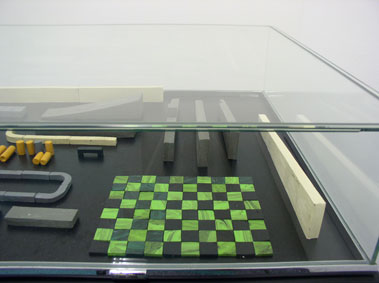



Dans un entretien sur la sculpture en photographie, Gabriel Orozco définissait la photographie comme « the space of the window ». C’est le titre qu’a choisi Leonor Antunes pour son exposition à Air de Paris et c’est également le titre d'un livre qu’elle a réalisé spécialement pour l’occasion. Comme pour ses précédentes publications, le format est celui d'un carnet Moleskine dont les pages intérieures se déploient en accordéon. Il reprend les dimensions du carnet mais agrandi dans un rapport d'échelle homothétique.
En 2004, Leonor Antunes a passé plusieurs mois en résidence à Paris. Postée devant sa fenêtre, l'artiste a reproduit en plasticine les éléments d'architecture qui lui faisaient face. Isolés et mis en forme, ces modèles font penser à des répliques low tech de sculptures minimalistes. Leur format équivoque de petits jouets de construction est en contradiction avec l'esthétique froide et distante de la ville. L’artiste a choisi de les présenter dans une vitrine de Jean Prouvé afin de créer une concordance des temps entre le design du support et la référence au minimalisme.
Par la suite, Leonor Antunes a photographié, une à une, les sculptures, avec en arrière-plan le paysage urbain qui les avait inspirées. Ces photographies sont celles qui composent son livre « the space of the window ». Au recto, le leporello compile dix photographies avec une mise au point sur le modèle tandis qu’au verso, ces mêmes photographies font la mise au point sur le paysage urbain. Avec une économie de moyens, elles produisent une équivalence entre l'intérieur et l'extérieur balayant la problématique de l'original et de la copie. Elles posent un regard "abstrait" et distrait sur la ville, et mettent en exergue les liens formels entre l'architecture et l’histoire de la sculpture.
Le livre est exposé sur un meuble en bois dessiné spécialement et posé sur un sol en linoléum reproduisant celui qui se trouvait dans l'atelier de l'artiste à Paris. Cette nouvelle mise en scène, à connotation sixties, nous projette dans un univers volontairement (re)construit et ambigu.
Cette exposition bénéficie du soutien de l'Institut Camoes à Paris.






In the course of an interview on the photography of sculpture, Gabriel Orozco defined photography as "the space of the window". This is the title chosen by Leonor Antunes both for her exhibition at Air de Paris and for the book she has created to mark the occasion. Like her earlier publications, this one uses the Moleskin notebook format with accordion pages, although the actual dimensions have been increased on a scale appropriate to the work.
In 2004 Antunes spent a residency of several months in Paris. Looking out her window at the details of the buildings opposite, she made plasticine models which, reworked and shown separately, are reminiscent of low-tech replicas of minimalist sculptures. Their equivocal format - they look like little building toys - is in contradiction with the cold, detached aesthetic of the city, and the artist has opted for showing them in a Jean Prouvé vitrine, establishing a temporal fit between the latter's design and the reference to minimalism.
Antunes then went on to photograph the sculptures one by one against the background of the urban landscape that had inspired them. These are the photographs that make up her book the space of the window . On the recto the leporello uses ten photographs focusing on the models themselves, while on the verso the focus is on the urban backdrop. With real economy of means the images establish an inside/outside equivalence that does away with the issue of the original and the copy. They bring an "abstract", absent-minded eye to the city, and highlight the formal links between architecture and the history of sculpture.
The book is displayed on a specially designed stand, while the floor covering is the same linoleum as in the artist's studio in Paris at the time. This move to a sixties-inflected mise en scène projects us into a deliberately (re)constructed, deliberately ambiguous world.
